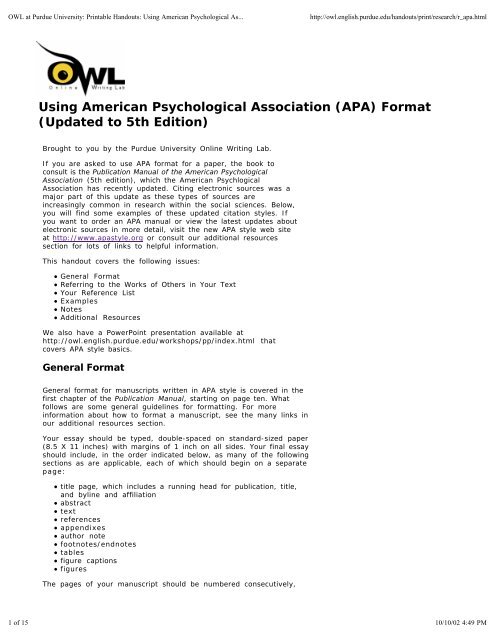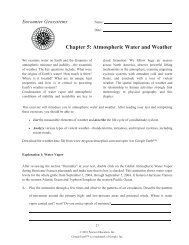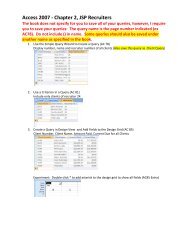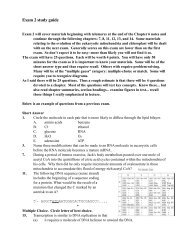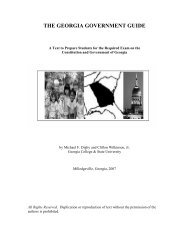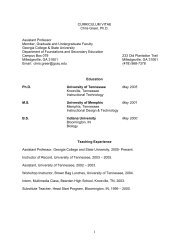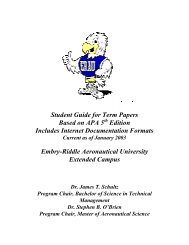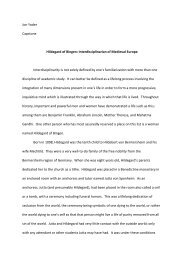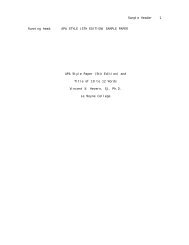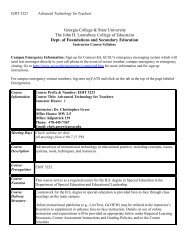Using American Psychological Association (APA) Format
Using American Psychological Association (APA) Format
Using American Psychological Association (APA) Format
You also want an ePaper? Increase the reach of your titles
YUMPU automatically turns print PDFs into web optimized ePapers that Google loves.
OWL at Purdue University: Printable Handouts: <strong>Using</strong> <strong>American</strong> <strong>Psychological</strong> As...http://owl.english.purdue.edu/handouts/print/research/r_apa.html<strong>Using</strong> <strong>American</strong> <strong>Psychological</strong> <strong>Association</strong> (<strong>APA</strong>) <strong>Format</strong>(Updated to 5th Edition)Brought to you by the Purdue University Online Writing Lab.If you are asked to use <strong>APA</strong> format for a paper, the book toconsult is the Publication Manual of the <strong>American</strong> <strong>Psychological</strong><strong>Association</strong> (5th edition), which the <strong>American</strong> Psychlogical<strong>Association</strong> has recently updated. Citing electronic sources was amajor part of this update as these types of sources areincreasingly common in research within the social sciences. Below,you will find some examples of these updated citation styles. Ifyou want to order an <strong>APA</strong> manual or view the latest updates aboutelectronic sources in more detail, visit the new <strong>APA</strong> style web siteat http://www.apastyle.org or consult our additional resourcessection for lots of links to helpful information.This handout covers the following issues:General <strong>Format</strong>Referring to the Works of Others in Your TextYour Reference ListExamplesNotesAdditional ResourcesWe also have a PowerPoint presentation available athttp://owl.english.purdue.edu/workshops/pp/index.html thatcovers <strong>APA</strong> style basics.General <strong>Format</strong>General format for manuscripts written in <strong>APA</strong> style is covered in thefirst chapter of the Publication Manual, starting on page ten. Whatfollows are some general guidelines for formatting. For moreinformation about how to format a manuscript, see the many links inour additional resources section.Your essay should be typed, double-spaced on standard-sized paper(8.5 X 11 inches) with margins of 1 inch on all sides. Your final essayshould include, in the order indicated below, as many of the followingsections as are applicable, each of which should begin on a separatepage:title page, which includes a running head for publication, title,and byline and affiliationabstracttextreferencesappendixesauthor notefootnotes/endnotestablesfigure captionsfiguresThe pages of your manuscript should be numbered consecutively,1 of 15 10/10/02 4:49 PM
OWL at Purdue University: Printable Handouts: <strong>Using</strong> <strong>American</strong> <strong>Psychological</strong> As...http://owl.english.purdue.edu/handouts/print/research/r_apa.htmlwith <strong>APA</strong> style (personal communication, November 3, 2002).Short Quotations<strong>Format</strong>ting short quotations is covered on pages 95-99 and 245-246 in thePublication Manual.To indicate quotations of fewer than 40 words in your text, enclose the quotationwithin double quotation marks. Provide the author, year, and specific page citationin the text, and include a complete reference in the reference list. Punctuationmarks, such as periods, commas, and semicolons, should appear after theparenthetical citation. Question marks and exclamation points should appear withinthe quotation marks if they are a part of the quotation but after the parentheticalcitation if they are a part of your text.Examples:She stated, "Students often had difficulty using <strong>APA</strong> style,"(Jones, 1998, p. 199), but she did not offer an explanation as to why.According to Jones (1998), "Students often had dificulty using <strong>APA</strong> style,especially when it was their first time" (p. 199).Jones (1998) found "students often had difficulty using <strong>APA</strong> style" (p. 199);what implications does this have for teachers?Long Quotations (block quotes)<strong>Format</strong>ting long quotations is covered on pages 117-118 and 292-293 in thePublication Manual.Place quotations longer than 40 words in a free-standing block of typewritten lines,and omit quotation marks. Start the quotation on a new line, indented five spacesfrom the left margin. Type the entire quotation on the new margin, and indent thefirst line of any subsequent paragraph within the quotation five spaces from thenew margin. Maintain double-spacing throughout. The parenthetical citation shouldcome after closing punctuation mark.Example:Jones's 1993 study found the following:Students often had difficulty using <strong>APA</strong> style,especially when it wastheir first time citing sources. This difficulty could be attributedto the fact that many students failed to purchase a style manual4 of 15 10/10/02 4:49 PM
OWL at Purdue University: Printable Handouts: <strong>Using</strong> <strong>American</strong> <strong>Psychological</strong> As...http://owl.english.purdue.edu/handouts/print/research/r_apa.htmlor to ask their teacher for help. (p. 199)Choosing double or single quotation marksIf you are using a quotation that uses quotation marks as a short quotation, usesingle quotation marks to set off the material that was originally enclosed inquotation marks. If you are using a quotation that uses quotation marks in a blockquote, use double quotation marks to set off the material that was originally inquotation marks.For more about in-text references in general, see the University ofWisconsin-Madison Writing Center's page on citations (athttp://www.wisc.edu/writetest/Handbook/Doc<strong>APA</strong>Citations.html) or visit the links inour additional resources section for more information.Your Reference List<strong>Format</strong>ting your reference list is covered in chapter four of the Publication Manual, which starts onpage 215. Further information about citing sources and formatting your reference list can be foundin our additional resources section. What follows are some general guidelines for formatting yourreference list.Your reference list should appear at the end of your paper. It provides the information necessaryfor a reader to locate and retrieve any source you cite in the body of the paper. Each source youcite in the paper must appear in your reference list; likewise, each entry in the reference list mustbe cited in your text.Your references should begin on a separate page from the text of the essay under the labelReferences (with no quotation marks, underlining, etc.), centered at the top of the page. It shouldbe double-spaced just like the rest of your essay. If you would like to see a sample reference list,these links to Sample <strong>APA</strong> Report (at http://www.thewritesource.com/<strong>APA</strong>/<strong>APA</strong>RESEARCH.HTM)and a<strong>APA</strong> Simulated Journal Article (at http://www-distance.syr.edu/apa5th.html) both provide samplereference lists that you can view.Basic RulesAuthors' names are inverted (last name first); give the last name and initials for all authors ofa particular work. Your reference list should be alphabetized by authors' last names.Personal communications, such as e-mail messages to you, or private interviews that youconducted with another person, should not be cited in your reference list because they are notretrievable sources for anyone else. You should make reference to these sources in yourin-text citations. (For more information, see page 214 of the Publication Manual.)If you have more than one work by a particular author, order them by publication date, oldestto newest (thus a 1991 article would appear before a 1996 article).When an author appears both as a sole author and, in another citation, as the first author of agroup, list the one-author entries first. If no author is given for a particular source, alphabetizeusing the title of the work, which will be listed in place of the author, and use a shortenedversion of the title for parenthetical citations.Use "&" instead of "and" when listing multiple authors of a single work (in text citations inparentheses, too).All lines after the first line of each entry in your reference list should be indented one-half inchfrom the left margin. This is called hanging indentation.Capitalize only the first letter of the first word of a title and subtitle of a work.5 of 15 10/10/02 4:49 PM
OWL at Purdue University: Printable Handouts: <strong>Using</strong> <strong>American</strong> <strong>Psychological</strong> As...http://owl.english.purdue.edu/handouts/print/research/r_apa.htmlItalicize titles of books and journals.Note that the italics in these entries often continue beneath commas and periods.Basic Forms for Sources in PrintAn article in a periodical (e.g., a journal, newspaper, or magazine)Author, A. A., Author, B. B., & Author, C. C. (Year, add month andday of publication for daily, weekly, or monthly publications).Title of article. Title of periodical, volume number, pages.NOTE:You need list only the volume number if the periodical uses continuous paginationthroughout a particular volume. If each issue begins with page 1, then you should list the issuenumber as well: Title of Periodical, Volume number(Issue number), pages. Note that the issuenumber is not italicized.A nonperiodical (e.g., book, report, brochure, or audiovisual media)Author, A. A. (Year of publication). Title of work: Capital letteralso for subtitle. Location: Publisher.NOTE: For "Location," you should always list the city, but you should also include the state if the cityis unfamiliar or if the city could be confused with one in another state.Part of a nonperiodical (e.g., a book chapter or an article in a collection)Author, A. A., & Author, B. B. (Year of publication). Title of chapter.In A. Editor & B. Editor (Eds.), Title of book (pages of chapter).Location: Publisher.NOTE: When you list the pages of the chapter or essay in parentheses after the book title, use"pp." before the numbers: (pp. 1-21). This abbreviation, however, does not appear before thepage numbers in periodical references.Basic Forms for Electronic SourcesArticle in an Internet PeriodicalAuthor, A. A., & Author, B. B. (Date of publication). Title of article.Title of journal, volume number(issue number if available).Retrieved month day, year, from http://Web address.Nonperiodical Internet Document (e.g., a Web page or report)Author, A. A., & Author, B. B. (Date of publication). Title of article.Retrieved month date, year, from http://Web address.NOTE: When an Internet document is more than one Web page, provide a URL that links to thehome page or entry page for the document. Also, if there isn't a date available for the documentuse (n.d.) for no date.Part of Nonperiodical Internet DocumentAuthor, A. A., & Author, B. B. (Date of publication). Title of article.In Title of book or larger document (chapter or section number).6 of 15 10/10/02 4:49 PM
OWL at Purdue University: Printable Handouts: <strong>Using</strong> <strong>American</strong> <strong>Psychological</strong> As...http://owl.english.purdue.edu/handouts/print/research/r_apa.htmlRetrieved from http://Web address.For more about electronic sources, see the <strong>APA</strong> style web site's coverage of electronic references (athttp://www.apastyle.org/elecref.html) or Frequently Asked Questions about <strong>APA</strong> Style (athttp://www.apastyle.org/faqs.html) from the <strong>APA</strong> web site, or visit our additional resources section.Basic Forms for Audiovisual SourcesA Motion Picture or Video TapeProducer, P. P. (Producer), & Director, D.D. (Director). (Date of publication).Title of motion picture [Motion picture]. Country of origin: Studio or distributor.If a movie or video tape is not available in wide distribution, add the following to your citation afterthe country of origin: (Available from Distributor name, full address and zip code).A Television Broadcast or Television SeriesProducer, P. P. (Producer). (Date of broadcast or copyright). Title of broadcast[Television broadcast or Television series]. City of origin: Studio or distributor.A Single Episode of a Television SeriesWriter, W. W. (Writer), & Director, D.D. (Director). (Date of publication). Title of episode[Television series episode]. In P. Producer (Producer), Series Title. City of origin:Studio or distributor.A music recordingSongwriter, W. W. (Date of copyright). Title of song [Recorded by artist if different fromsong writer]. On Title of album [Medium of recording]. Location: Label. (Recording dateif different from copyright date)For more about citing audiovisual media, see pages 266-269 of the Publication Manual.7 of 15 10/10/02 4:49 PM
OWL at Purdue University: Printable Handouts: <strong>Using</strong> <strong>American</strong> <strong>Psychological</strong> As...http://owl.english.purdue.edu/handouts/print/research/r_apa.html<strong>American</strong> <strong>Psychological</strong> <strong>Association</strong>.An article or chapter of a bookO'Neil, J. M., & Egan, J. (1992). Men's and women's gender role journeys:Metaphor for healing, transition, and transformation. In B. R.Wainrib (Ed.), Gender issues across the life cycle (pp. 107-123).New York: Springer.A government publicationNational Institute of Mental Health. (1990). Clinical training in seriousmental illness (DHHS Publication No. ADM 90-1679). Washington, DC:U.S. Government Printing Office.A book or article with no author or editor namedMerriam-Webster's collegiate dictionary (10th ed.).(1993).Springfield, MA: Merriam-Webster.New drug appears to sharply cut risk of death from heart failure.(1993, July 15). The Washington Post, p. A12.NOTE: For parenthetical citations of sources with no author named, use a shortened version of the title insteaname. Use quotation marks and italics as appropriate. For example, parenthetical citations of the two sourcesappear as follows: (Merriam-Webster's, 1993) and ("New Drug," 1993).A translated work and/or a republished workLaplace, P. S. (1951). A philosophical essay on probabilities(F. W. Truscott & F. L. Emory, TranDover. (Original work published 1814)NOTE: When you cite this work in text, it should appear with both dates: Laplace (1814/1951).A review of a book, film, television program, etc.Baumeister, R. F. (1993). Exposing the self-knowledge myth [Reviewof the book The self-knower: A hero under control]. ContemporaryPsychology, 38, 466-467.An entry in an encyclopediaBergmann, P. G. (1993). Relativity. In The new encyclopediabritannica (Vol. 26, pp. 501-508). Chicago: Encyclopedia Britannica.An online journal articleKenneth, I. A. (2000). A Buddhist response to the nature ofhuman rights. Journal of Buddhist Ethics, 8(4). RetrievedFebruary 20, 2001, from:http://www.cac.psu.edu/jbe/twocont.htmlChapter or section of an online document9 of 15 10/10/02 4:49 PM
OWL at Purdue University: Printable Handouts: <strong>Using</strong> <strong>American</strong> <strong>Psychological</strong> As...http://owl.english.purdue.edu/handouts/print/research/r_apa.htmlThe Foundation for a Better World. (2000). Pollution and bananacream pie.In Great chefs cook with chlorofluorocarbonsand carbon monoxide (Chap. 3). Retrieved July 13, 2001, from:http://www.bamm.com/cream/pollution/bananas.htmNOTE: Use a chapter or section identifier and provide a URL that links directly to the chapter section, not thethe Web site.Message posted to an online newsgroup, forum, or discussion groupFrook, B. D. (1999, July 23). New inventions in the cyberworldof toylandia [Msg 25]. Message posted tohttp://groups.earthlink.com/forum/messages/00025.htmlNOTE: If only the screen name is available for the author, then use it. Be sure to provide the exact date of thFollow the date with the subject line, the thread of the message (not in italics). Provide any identifiers in bracktitle, as in other types of references.A Motion Picture or Video Tape with international or national availabilitySmith, J.D. (Producer), & Smithee, A.F. (Director). (2001). Really Big Disaster Movie[Motion picture]. United States: Paramount Pictures.A Motion Picture or Video Tape with limited availabilityHarris, M. (Producer), & Turley, M. J. (Director). (2002). Writing Labs: A History[Motion picture]. (Available from Purdue University Pictures, 500 Oval Drive,West Lafayette, IN 47907)A Television BroadcastImportant, I.M. (Producer). (1990, November 1). The Nightly News Hour.[Television broadcast]. New York: Central Broadcasting Service.A Television SeriesBellisario, D.L. (Producer). (1992). Exciting Action Show.[Television series]. Hollywood: <strong>American</strong> Broadcasting Company.A Single Episode of a Television SeriesWendy, S. W. (Writer), & Martian, I.R. (Director). (1986). The rising angel and the falling ape.[Television series episode]. In D. Dude (Producer), Creatures and monsters. Los Angeles:Belarus Studios.A music recordingTaupin, B. (1975). Someone saved my life tonight [Recorded by Elton John].10 of 15 10/10/02 4:49 PM
OWL at Purdue University: Printable Handouts: <strong>Using</strong> <strong>American</strong> <strong>Psychological</strong> As...http://owl.english.purdue.edu/handouts/print/research/r_apa.htmlOn Captain Fantastic And The Brown Dirt Cowboy [CD]. London: Big Pig Music Limited.If your particular source is not listed, use the basic forms to determine the correct format, check the Publicationconsult the <strong>APA</strong> style website (at http://www.apastyle.org), especially their Frequently Asked Questions abouthttp://www.apastyle.org/faqs.html) and their coverage of electronic references (at http://www.apastyle.org/eleadditional resources section also has some links to examples and resources.11 of 15 10/10/02 4:49 PM
OWL at Purdue University: Printable Handouts: <strong>Using</strong> <strong>American</strong> <strong>Psychological</strong> As...http://owl.english.purdue.edu/handouts/print/research/r_apa.htmlA Note on NotesBecause long explanatory notes can be distracting to readers, <strong>APA</strong> style guidelinesrecommend the use of endnotes/footnotes. In the text, place a superscript numeralimmediately after the text about which you would like to include more information (e.g.,Scientists examined the fossilized remains of the wooly-wooly yak.1) Number the notesconsecutively in the order they appear in your paper. At the end of the paper, create aseparate page labeled Notes (centered at the top of the page). Below are examples of twokinds of notes.1. evaluative bibliographic comments1. See Blackmur (1995), especially chapters three and four, foran insightful analysis of this extraordinary animal.2. On the problems related to yaks, see Wollens(1989, pp. 120-135); for a contrasting view, seePyle (1992).2. explanatory or additional information considered too digressive for the main text3. In a recent interview, she (Weller, 1998) reiteratedthis point even more strongly: "I am an artist, not a yak!" (p. 124).Additional ResourcesIt's always best to consult the Publication Manual first for any <strong>APA</strong> question. If you are using<strong>APA</strong> style for a class assignment, it's a good idea to consult your professor, advisor, TA, orother campus resources for help with using <strong>APA</strong> style -- they're the ones who can tell you howthe style should apply in your particular case. For extraordinary questions that aren't coveredclearly in the style manual or haven't been answered by your teacher or advisor, contact theWriting Lab for help at (765) 494-3723 or email owl@owl.english.purdue.edu.Here are some other resources for using <strong>APA</strong> style and writing research papers that might alsohelp answer your questions.Print ResourcesHere are some print resources for using <strong>APA</strong> style. Most of these books are probably availablein your local library.From the <strong>American</strong> <strong>Psychological</strong> <strong>Association</strong>:Publication Manual of the <strong>American</strong> <strong>Psychological</strong> <strong>Association</strong> (5th edition) (ISBN:1557987912)Mastering <strong>APA</strong> Style : Student's Workbook and Training Guide (ISBN: 1557988919)Mastering <strong>APA</strong> Style : Instructor's Resource Guide (ISBN: 1557988900)Displaying Your Findings: A Practical Guide for Creating Figures, Posters, and Presentations(ISBN: 1557989788)From other publishers:12 of 15 10/10/02 4:49 PM
OWL at Purdue University: Printable Handouts: <strong>Using</strong> <strong>American</strong> <strong>Psychological</strong> As...http://owl.english.purdue.edu/handouts/print/research/r_apa.htmlThe World's Easiest Guide to <strong>Using</strong> the <strong>APA</strong> (ISBN: 0964385317)Writing With Style: <strong>APA</strong> Style Made Easy (ISBN: 0534363652)Writing With Style: <strong>APA</strong> Style for Social Work (ISBN: 0534263119)Online and Electronic ResourcesFrom the <strong>American</strong> <strong>Psychological</strong> <strong>Association</strong>:<strong>APA</strong> Style Website: http://www.apastyle.org/About <strong>APA</strong> Style: http://www.apastyle.org/aboutstyle.htmlElectronic References in <strong>APA</strong> Style: http://www.apastyle.org/elecref.htmlElectronic Media and URLs: http://www.apastyle.org/elecmedia.htmlGeneral Forms for Electronic References: http://www.apastyle.org/elecgeneral.htmlReference Examples for Electronic Materials:http://www.apastyle.org/elecsource.htmlCitations in Text of Electronic Material: http://www.apastyle.org/electext.html<strong>APA</strong> Style Tips: http://www.apastyle.org/styletips.htmlTip of the Week: http://www.apastyle.org/tipweek.htmlFrequently Asked Questions about <strong>APA</strong> Style: http://www.apastyle.org/faqs.html<strong>APA</strong> Style Helper: http://www.apastyle.org/stylehelper/(software program; requirespurchase)<strong>APA</strong> Style Guide for Electronic Resources: http://www.apastyle.org/styleelecref.html (PDFdownload; requires purchase)Other online resources<strong>Format</strong>ting your paper and writing in <strong>APA</strong> style<strong>APA</strong> style essentials: http://www.vanguard.edu/faculty/ddegelman/index.cfm?doc_id=796(from Vanguard University of Southern California)Documentation Styles: <strong>APA</strong> Documentation Style:http://www.wisc.edu/writetest/Handbook/Doc<strong>APA</strong>.html#review(from the University of Wisconsin-Madison Writing Center)<strong>APA</strong> Manuscript <strong>Format</strong>:http://www.dianahacker.com/resdoc/social_sciences/manfor.html(from Research and Documentation Online by Diana Hacker)<strong>APA</strong> Style <strong>Format</strong>ting Guide: http://www.indstate.edu/nurs/mary/apa2.htm(from Indiana State University)<strong>APA</strong>-Style Checklist: http://spsp.clarion.edu/mm/RDE3/C14/Checklist.html(from Bill Southerly)<strong>APA</strong> 5th Edition Guidelines:http://www.uca.edu/divisions/academic/writing/OWL/LINKS/OnlineHandouts/apabasics.PDF(Adobe PDF from the University of Central Arkansas)<strong>APA</strong> <strong>Format</strong> for Annotated Bibliographies:http://www.lesley.edu/library/guides/citation/apa_annotated.html(from Lesley University)<strong>APA</strong> style templates and sample papers<strong>APA</strong> Style Templates in Microsoft Word:http://bellarmine.lmu.edu/faculty/lswenson/helpstuff.html(by Barbara Swenson, Loyola University Marymount)<strong>APA</strong> Style Template for Microsoft Word:http://www.tc.umn.edu/~gwin0005/apa-template.html(by Derek Gwinn)Sample paper: <strong>APA</strong> style:http://www.dianahacker.com/resdoc/social_sciences/sample.html(from Research and Documentation Online by Diana Hacker)Sample <strong>APA</strong> Report: http://www.thewritesource.com/<strong>APA</strong>/<strong>APA</strong>RESEARCH.HTM(from The Write Source)<strong>APA</strong> Simulated Journal Article: http://www-distance.syr.edu/apa5th.html(from Elmira College)A Sample Paper in <strong>American</strong> <strong>Psychological</strong> <strong>Association</strong> Style:http://valencia.cc.fl.us/lrcwest/apapaper.html(From Valencia Community College)13 of 15 10/10/02 4:49 PM
OWL at Purdue University: Printable Handouts: <strong>Using</strong> <strong>American</strong> <strong>Psychological</strong> As...http://owl.english.purdue.edu/handouts/print/research/r_apa.htmlSample reference list:http://www.vaniercollege.qc.ca/litc/tutorials/apa_style/samples.html(from Vanier College)Sample reference list: http://www.vanguard.edu/psychology/references.pdf(PDF from Vanguard University)Documenting and referencing sources<strong>Using</strong> <strong>APA</strong> Style to Cite and Document Sources:http://www.bedfordstmartins.com/online/cite6.html(from Bedford St. Martin's Online!)<strong>APA</strong> Style: Documenting Sources:http://www.dianahacker.com/resdoc/social_sciences/intext.html(from Research and Documentation Online by Diana Hacker)<strong>APA</strong> Style Electronic <strong>Format</strong>s: http://www.westwords.com/guffey/apa.html(from Dr. Mary Ellen Guffey)<strong>APA</strong> Style crib sheet: http://www.crk.umn.edu/library/links/apa5th.htm(from the University of Minnesota at Crookston)Bibliography Style Handbook (<strong>APA</strong>):http://www.english.uiuc.edu/cws/wworkshop/bibliography_style_handbookapa.htm(from the Writer's Workshop)<strong>APA</strong> Reference Style: http://humanities.byu.edu/linguistics/Henrichsen/<strong>APA</strong>/<strong>APA</strong>02.html(from Brigham Young University)How to Cite Online Nursing Resources <strong>Using</strong> <strong>APA</strong> Style:http://www.library.unr.edu/subjects/guides/apa.html(from the University of Nevada at Reno)<strong>APA</strong> Citation Style: Examples for Nursing Students:http://employees.csbsju.edu/proske/nursing/<strong>APA</strong>.htm(from College of St. Benedict/St. John's University)General resources for writing and researchOn Purdue's OWL:Annotated bibliographies:http://owl.english.purdue.edu/handouts/general/gl_annotatedbib.htmlResearch Paper workshop:http://owl.english.purdue.edu/workshops/hypertext/ResearchW/index.htmlResearch Report workshop:http://owl.english.purdue.edu/workshops/hypertext/reportW/index.htmlResearch and Documenting Sources handouts:http://owl.english.purdue.edu/handouts/research/index.htmlResearch and documenting sources PowerPoint presentations :http://owl.english.purdue.edu/workshops/pp/index.htmlEvaluating Sources workshop:http://owl.english.purdue.edu/workshops/hypertext/EvalSrcW/index.htmlSearching the Web workshop: http://owl.english.purdue.edu/internet/search/index.htmlStarting points for Internet research:http://owl.english.purdue.edu/internet/resources/sourceofinfo.htmlOther online resourcesResearch and Documentation Online: http://www.dianahacker.com/resdoc/(by Diana Hacker)A Research Guide for Students: http://www.aresearchguide.com/(by I. Lee)Other citation stylesPurdue's OWL also offers information about other citation methods and electronic sources. Wehave the following handouts:<strong>Using</strong> MLA <strong>Format</strong>: http://owl.english.purdue.edu/handouts/research/r_mla.html<strong>Format</strong>ting in Sociology:http://owl.english.purdue.edu/handouts/research/r_docsocio.htmlResources for Documenting Sources:14 of 15 10/10/02 4:49 PM
OWL at Purdue University: Printable Handouts: <strong>Using</strong> <strong>American</strong> <strong>Psychological</strong> As...http://owl.english.purdue.edu/handouts/print/research/r_apa.htmlhttp://owl.english.purdue.edu/handouts/research/r_docsources.htmlCiting Electronic Sources:http://owl.english.purdue.edu/handouts/research/r_docelectric.htmlHandout revised November 2001, David Neyhart and Erin KarperResources updated September 2002, Erin KarperThe following information must remain intact on every handout printed fordistribution.This page is located athttp://owl.english.purdue.edu/handouts/print/research/r_apa.htmlCopyright ©1995-2002 by OWL at Purdue University and Purdue University. Allrights reserved.Use of this site, including printing and distributing our handouts, constitutesacceptance of our terms and conditions of fair use, available athttp://owl.english.purdue.edu/lab/fairuse.html.To contact OWL, please visit our contact information page athttp://owl.english.purdue.edu/lab/contact.html to find the right person to call oremail.15 of 15 10/10/02 4:49 PM


